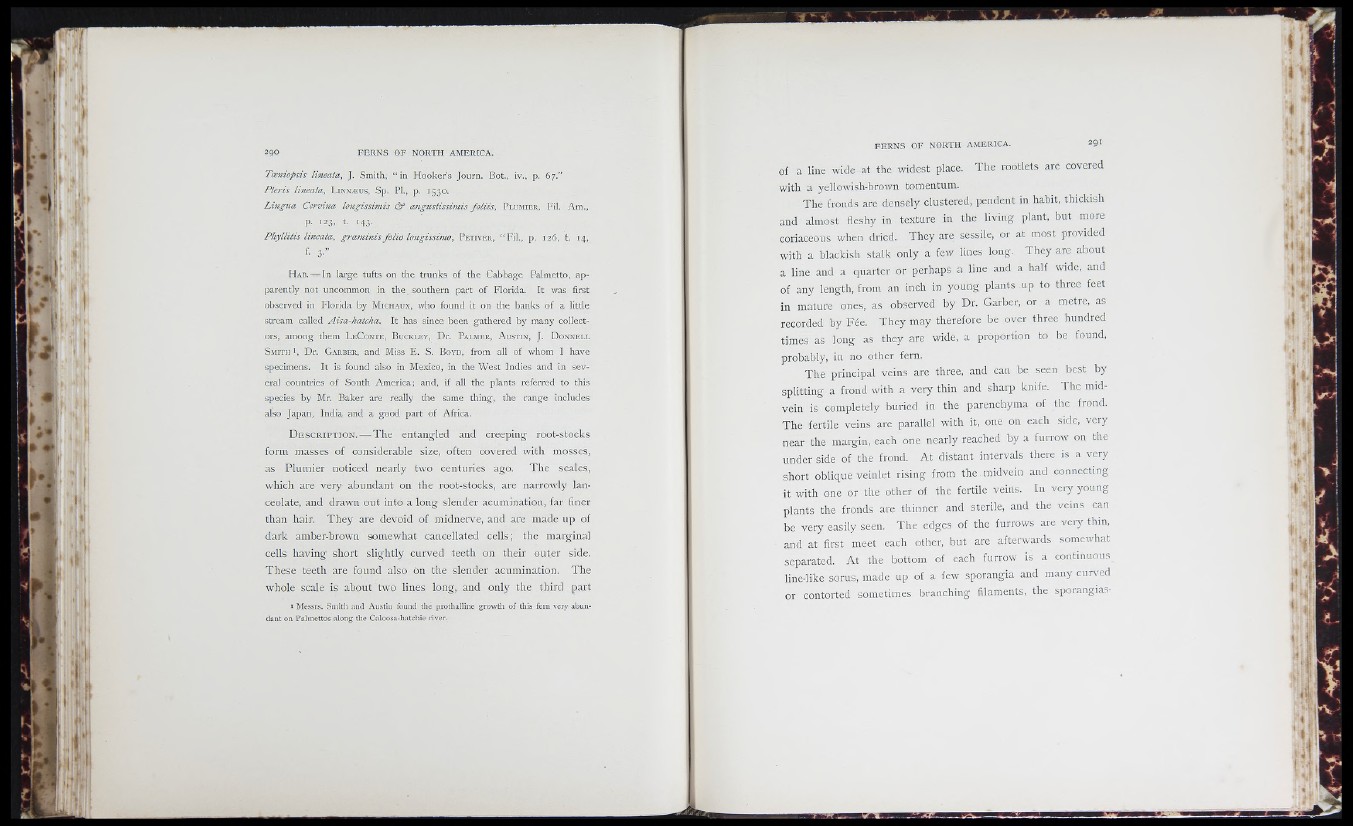
J
i*
1»‘
M
r i
r i '
II»
p .
• i
ri. Il
290 F E R N S O F N O R TH AMERICA.
Toeniopsis lineata, ]. Smith, “ in Hooker’s Journ. Bot., iv., p. 67.”
Pteris lineata, L i n n æ u s , Sp. Pl., p. 1530.
Lingua Cervina longissimis & angustissimis fo liis , P l u m ie r , Fil. Am.,
p . 123, t. 143.
Phyllitis lineata, graminis fo lio longissimo, P e t i v e r , “ Fil., p. 126, t . 14,
f- 3.”
H a b . — In large tufts on the trunks of the Cabbage Palmetto, apparently
not uncommon in the_ southern part of Florida. It was first
observed in Florida by M ic i -ia u x , who found it on the banks of a little
stream called Aisa-hatcha. It has since been gathered by many collectors,
among them L e C o n t e , B u c k l e y , Dr. P a l m e r , A u s t in , J. D o n n e l l
S m it h 1, Dr. G a r b e r , and Miss E. S. B o y d , from all of whom I have
specimens. It is found also in Mexico, in the West Indies and in several
countries of South America; and, if all the plants referred to this
species by Mr. Baker are really the same thing, the range includes
also Japan, India and a good part of Africa.
D e s c r i p t i o n . — The entangled and creeping root-stocks
form masses of considerable size, often covered with mosses,
as Plumier noticed nearly two centuries ago. The scales,
which are very abundant on the root-stocks, are narrowly lanceolate,
and drawn out into a long slender acumination, far finer
than hair. They are devoid of midnerve, and are made up of
dark amber-brown somewhat cancellated cells; the marginal
cells having short slightly curved teeth on their outer side.
These teeth are found also on the slender acumination. The
whole scale is about two lines long, and only the third part
Ï Messrs. Sm ith and Austin found the prothallino grow th o f this fern very abundant
on Palmettos along the Caloosa-hatchie river.
. 1 ^ -
é.
of a line wide at the widest place. The rootlets are covered
with a yellowish-brown tomentum.
The fronds are densely clustered, pendent in habit, thickish
and almost fleshy in texture in the living plant, but more
coriaceous when dried. They are sessile, or at most provided
with a blackish stalk only a few lines long. They are about
a line and a quarter or perhaps a line and a half wide, and
of any length, from an inch in young plants up to three feet
in mature ones, as observed by Dr. Garber, or a metre, as
recorded by Fée. They may therefore be over three hundred
times as long as they are wide, a proportion to be found,
probably, in no other fern.
The principal veins are three, and can be seen best by
splitting a frond with a very thin and sharp knife. The midvein
is completely buried in the parenchyma of the frond.
The fertile veins are parallel with it, one on each side, very
near the margin, each one nearly reached by a furrow on the
under side of the frond. At distant intervals there is a very
short oblique veinlet rising from the midvein and connecting
it with one or the other of the fertile veins. In very young
plants the fronds are thinner and sterile, and the veins can
be very easily seen. The edges of the furrows are very thin,
and at first meet each other, but are afterwards somewhat
separated. At the bottom of each furrow is a continuous
line-like sorus, made up of a few sporangia and many curved
or contorted sometimes branching filaments, the sporangia.s